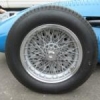In his last book, "Maserati in the World Sports Car & Manufacturers Championships from 1953 to 1966", Michel Bollée has given to each car a chassis number, of course not an easy task and a very difficult one regarding the A6GCS.
The 350S was an unsuccessful car.
Two were built for the 1956 Mille Miglia, one for Piero Taruffi, a monoposto as he was racing alone, and one biposto for Stirling Moss and Denis Jenkinson.
Denis Jenkinson was in Italy the week before the Mille Miglia and was at the Maserati factory and gave a precise account of the building of the cars.
The monoposto with Taruffi driving was first tested at the Modena circuit on the 24th of April. Taruffi did not like the car and decided to drive a 300S in the race.
The Moss car came only out of the factory on the 28th of April and was first tested at the end of the night by Bertocchi; when Moss arrived early in the morning he could test the car before taking the road to Brescia for the start of the Mille Miglia the next morning at 5H54.
Before the last Bollée book, and also mentionned in his previous books, the Moss 350S at the Mille Miglia was said to be chassis #3501, the monoposto #3502.
Bollée in his last book writes that the Moss car was #3502, the monoposto #3501.
During the Mille Miglia, Moss went off the road, the car was damaged.
The factory did not repair the Moss car as a 350S but rebuilt it with many changes and the new V8 4,5l engine; the car was renamed 450S chassis #4501 and appeared as T car at the Swedish Grand Prix. The car was not seen later, probably scrapped.
The monoposto was sold to Luigi Piotti who raced it at Bari and Reims in 1956.
Maserati built a third 350S end of 1956 (a 300S chassis with a 3,5l engine) for Tony Parravano, chassis #3502.
Chassis #3101 still existing, the original #3502 changed into #4501 and scrapped, all looks logical.
Can other Maserati historians confirm (or refuse) the Bollée numbers ?












